As Cities Grow Across Africa, They Must Plan for Water Security
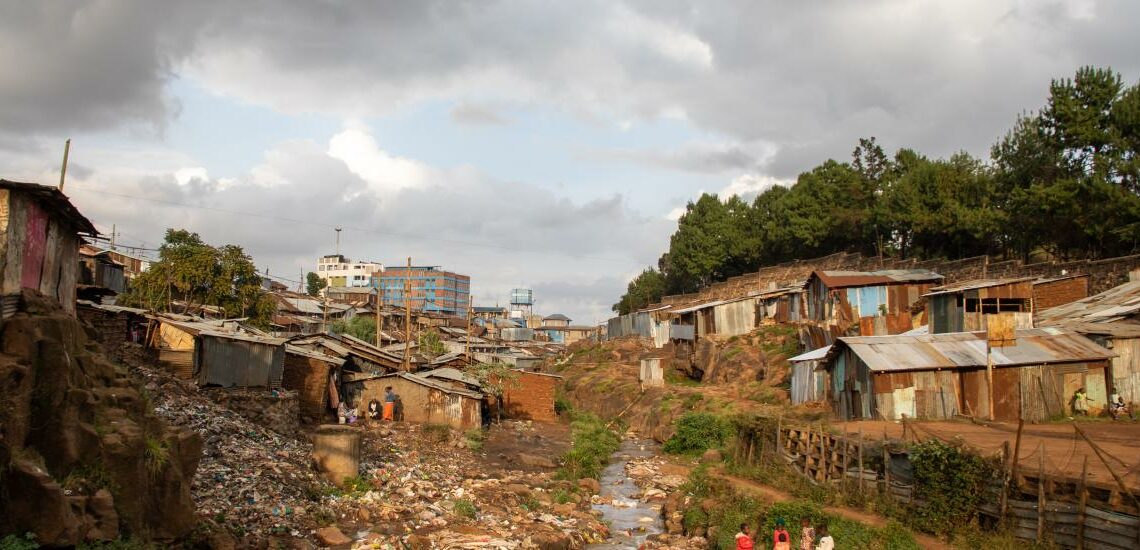
Here’s a startling figure: 1.5 billion people will live in African cities by 2050, more than double the number today. African cities — including unplanned urban areas and informal settlements — are already facing staggering challenges: poverty, the need for more and better jobs, and a lack of housing and basic infrastructure, all of which will be compounded by rapid urban growth.
Yet, in our experience, one of the biggest risks facing cities across Africa is not well understood: water insecurity.
Inequitable access to basic water services, loss of natural water systems, unplanned urban expansion, and more frequent and intense droughts and floods will undermine the security, well-being and development prospects of Africa’s urban dwellers — 60% of whom live in slums.
Take for example the city of Dire Dawa in Ethiopia, which is frequently hit by floods claiming the lives of hundreds, while most of its inhabitants have no access to clean water. And the drought in 2020 in Bulawayo, Zimbabwe, that pushed some families to sleep overnight in water queues, making it hard to adhere to pandemic guidelines for not only handwashing but also social distancing.
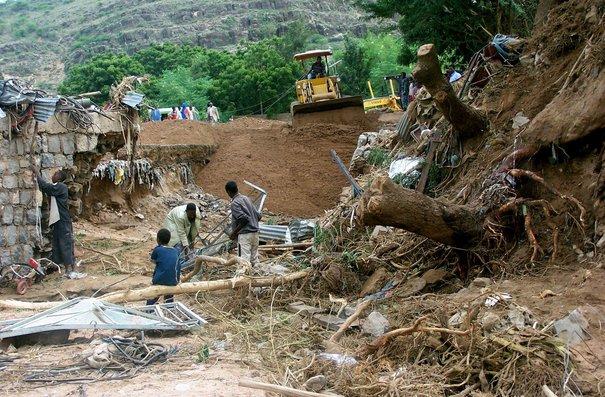
On this rapidly urbanizing continent, cities are unplanned, expanding outward into watersheds and cropland, depleting water resources and natural assets in the periphery. Local authorities lack capacity to manage the rapid growth of cities, minimize its adverse effects, and, at the same time, provide basic services to citizens in need.
The loss of natural soils, streams, wetlands and forests impact water replenishment and drainage, making it difficult — if not impossible — for city-regions to cope with water security and other risks like flooding and landslides. Climate change will adversely impact an already challenging situation.
But with the right vision and support, cities can play a lead role addressing these problems. As engines of economic growth, they can stir action among adjacent regions, national governments and a wide range of other partners; 143 cities in sub-Saharan Africa generate 50% of the region’s Gross Domestic Product (GDP) and are expected to contribute more than two-thirds of GDP growth by 2025. City leaders are also closest to where water insecurity hits hardest: the poor and vulnerable communities who make up more than half of the urban population.
And, crucially, most cities in Africa are yet to be built. This opens the potential to bypass traditional, inflexible approaches and instead adapt more flexible and circular water-sensitive designs that respond better to climate extremes.
In short, African cities are at a unique moment: they can succumb to chaotic, unplanned expansion and outmoded water management or chart a more sustainable approach that lays a foundation for prosperity by “getting water right.” Now is the moment for a pan-African urban water resilience agenda to offer an integrated approach to the water challenges they face.
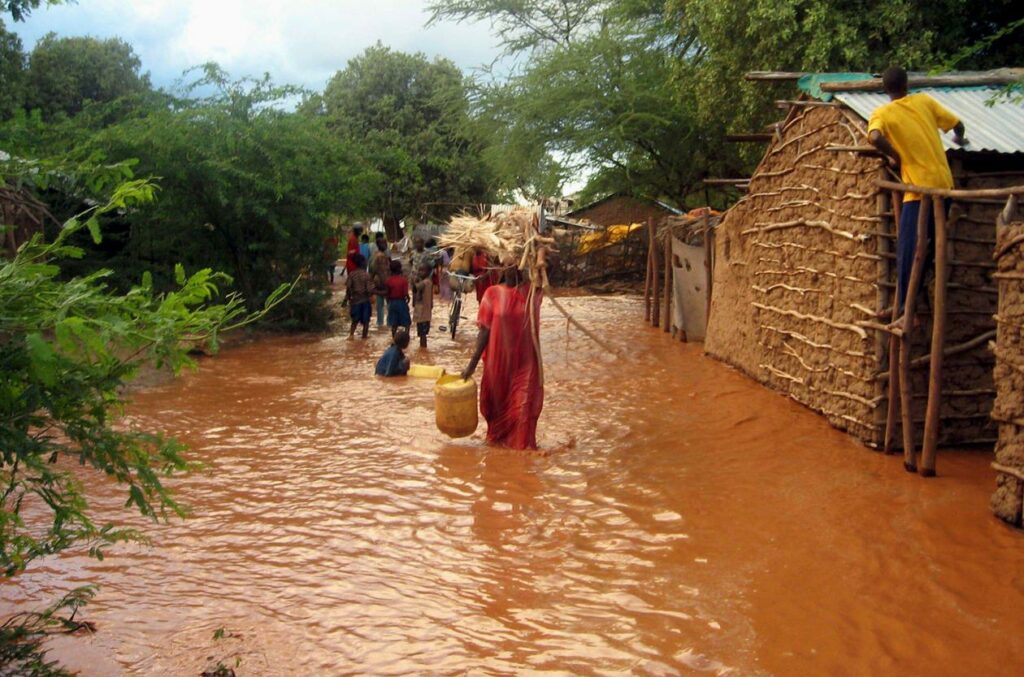
The Chance to Get Water Right
Water crises create vulnerabilities across multiple systems vital for human well-being and development — from food and energy production, to hygiene and health. At its core, water resilience means ensuring communities have access to safe, reliable and affordable water, and that water resources are protected through disaster preparedness and water-sensitive infrastructure designs.
As rapid urbanization continues, the challenge and opportunity to implement best practices of water-sensitive designs are closely related.
To get water right is now a matter of urgency across Africa, where the number of water-insecure urban residents is rising — even when dams are full and aquifers are replenished by the wet season. Nearly 63% of urban areas in sub-Saharan Africa lack access to basic water and sanitation.
A 2019 WRI analysis of five cities in sub-Saharan Africaillustrated that less than 25% of the urban population has access to safely managed water, while only 42% have access to safely managed sanitation services. The service gap between the provision of water and the growing urban population is widening.
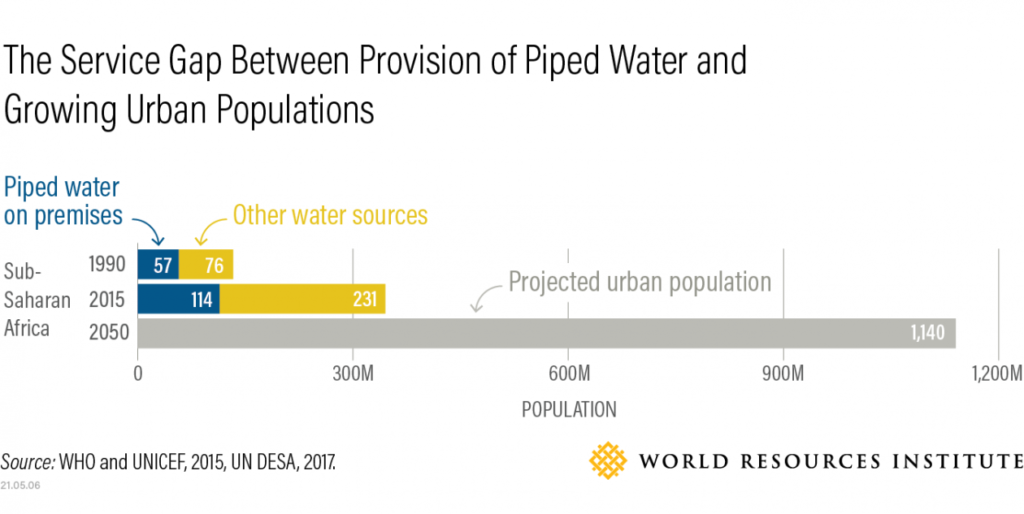
An Emerging Role for Cities to Drive Water Resilience
Though the political, regulatory and fiscal powers of local governments vary across the continent, we believe cities are uniquely situated to drive change at the local level. For cities to galvanize action — both within their boundaries and across multiple stakeholders and levels of government — requires a systemic approach that brings the urban water supply in sync with regional water resource management, while addressing urban growth and climate adaptation. This would not only be useful for water but could form the bedrock for building resilience against allfuture challenges that transcend boundaries.
Take water management, which in most cities is scattered across different authorities with varying mandates: Water supply may be managed by the water utility, source water management may sit within national agencies, while management of water assets may sit with the environmental authorities. Greater integration and coordination across agencies is essential, and city leaders can harness new ways of working, bringing together actors vertically and horizontally, building local partnerships within cities and fostering integrated solutions across the entire watershed region.
Yet while cities can drive ambition, they cannot build resilience alone. National or provincial governments have a significant role to play, with cities expanding across subnational government borders. Urban water resilience requires a multi-level, city-regional approach, addressing the larger basin area and the functional urban region.
Three Pathways for Building Urban Water Resilience in Africa
There are many elements to building water-resilient cities, but here are three pathways critical for African cities:
1. Urban Infrastructure Matters: How Cities Plan Water Has to Change
To increase water resilience, we need to change how cities are being built. Cities should be planned to meet water needs, using approaches that extend beyond the city limits and consider systems change throughout entire city-regions.
First, urban planning and management experts need to be informed of the risks to the natural water cycle and flow regimes, placing the right incentives and regulations to manage city expansion. Cities contain extensive built-up infrastructure and impermeable surfaces, such as buildings and roads, leaving flood waters with nowhere to go but into the streets. This can then mix with raw sewage or flood pit latrines, creating the perfect setup for dangerous disease outbreaks such as cholera.
There are multiple benefits to redirecting expansion so that it avoids green spaces and other areas important for flood control. Ecologically-sensitive land use planning and management will support the health of surrounding bodies of water, key areas for buffering storms, support peri-urban agriculture and provide regional food security.
Planning within the regional context can generate immense cost savings. It requires working with regional land authorities and ensuring that land-use plans are enforced to prevent indiscriminate development.
For example, through work with thousands of smallholder farmers in Nairobi, Kenya, The Nature Conservancy has implemented soil-retention and water conservation practices upstream of the city’s drinking water supply. This prevents costly downstream issues — such as sedimentation and flooding — and is estimated to return $21.5 million in benefits over 30 years.
Second, city leaders should anticipate water-related disasters and develop city infrastructure to withstand them. Investing in “green plus gray” approaches that combine traditional engineered solutions with nature-based infrastructure can build greater resilience to a wider range of extreme conditions, both wet and dry.
WRI is working with 67 cities globally, including seven in sub-Saharan Africa, to implement green infrastructure strategies such as better conservation, management and restoration of forests within cities, source watersheds and faraway forests.
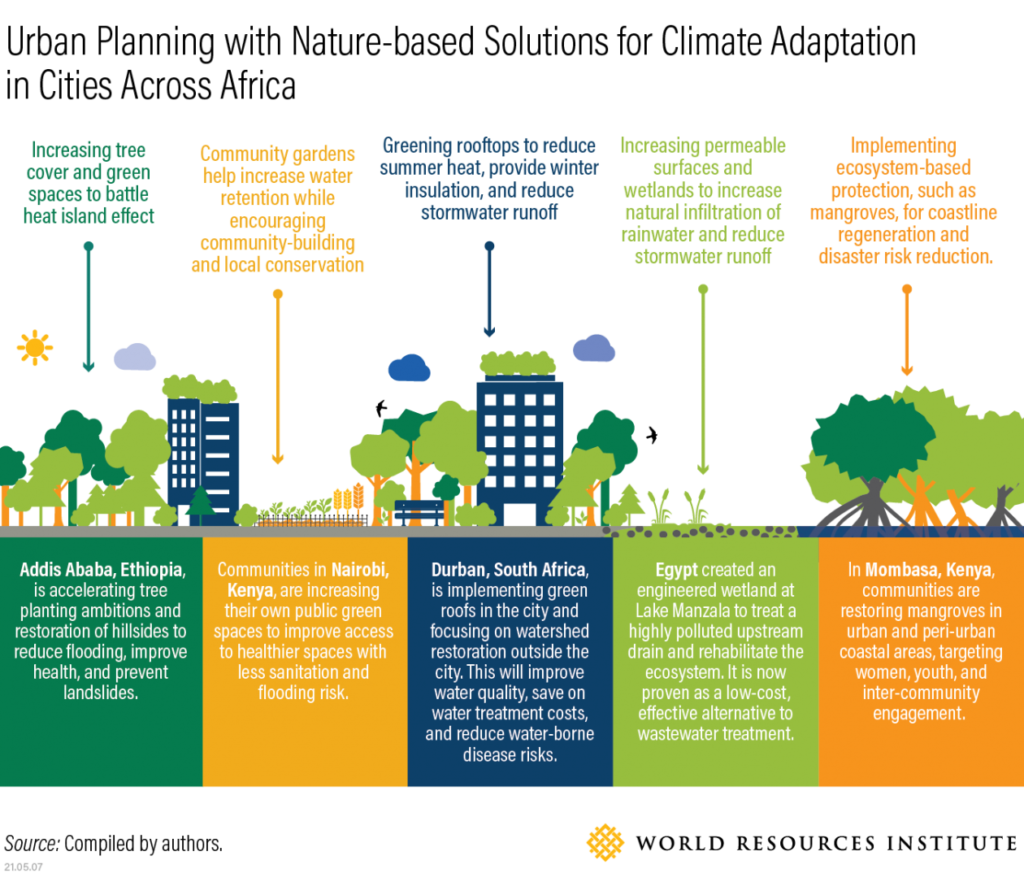
Third, water supply and management must adapt to constrained resources. In 2018, for instance, Cape Town nearly reached Day Zero, a day when its municipal taps would be shut off because the city would’ve run out of water. This highlighted the importance of diversifying water supply and management options and exposed the danger of overreliance on rain-fed reservoirs also used for irrigated agriculture. The city created a new Water Strategyto increase investment in storage, quality and greywater reuse.
Meanwhile, in arid Windhoek, Namibia, the water utility has been producing drinking water from recycled wastewater since the 1960s and recharging its aquifers with surplus reclaimed water since the mid-2000s.
A more strategic, better informed gray-blue-greenapproach to infrastructure investments can provide more effective solutions for adaptation, water supply and resource management and result in healthier spaces. With the right mixture of planning and investment, African cities can leapfrog to infrastructure that is water-sensitive, flexible and risk-informed.
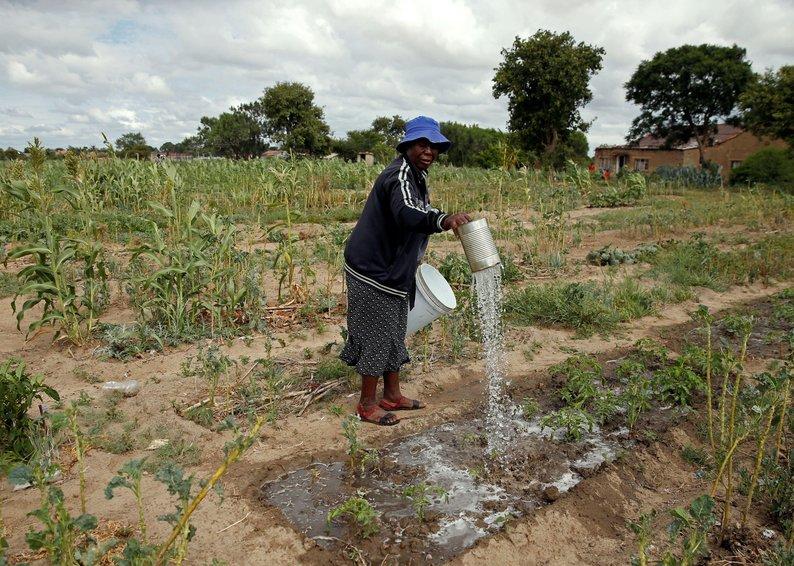
2. Prioritize Vulnerable Communities
Providing safe, sustainable and resilient water and sanitation must be a centerpiece of urban resilience efforts. This will require massively scaled investment to improve the coverage, safety and affordability of these services — prioritizing the most water-insecure communities.
To better understand local risks and solutions, cities and utilities will need to integrate local data, knowledge and community participation, bringing together geospatial data that focuses on physical infrastructure and risks to assets with socioeconomic data to identify the most vulnerable areas and communities.
For example, Slum Dwellers International has mobilized thousands of communities in over 400 cities around the world to collect data through methods such as household-to-household socioeconomic surveys, helping to reveal nuanced vulnerabilities and investment needs on-the-ground.
Policies that increase public, affordable water connections and sanitation options will need to target the most socially vulnerable, leveraging and integrating existing networks of small-scale, decentralized and informal providers and systems. But there may be limitations within existing policy frameworks beyond the water sector that need to be addressed to ensure equitable water access, including in housing, land and tenure security.
For example, a recent WRI webinar highlighted that Nairobi’s utility has a pro-poor policy of subsidizing new water connections in informal settlements, but this can only be used for settlements on public land; this policy thus cannot cover at least half of Nairobi’s informal settlements residing on privately owned land.
Alternatively, one of the most effective and inclusive approaches is comprehensively upgrading core services in the most water-insecure areas — such as dense slums, hillside settlements or peripheral neighborhoods outside of the public water network. This prevents displacement and unintended consequences from piecemeal, incremental improvements.
In Kibera, Nairobi, for example, an informal settlement home to over 300,000 dwellers, residents and a local nonprofit implemented strategies to upgrade water, sanitation, drainage and waste services. Informed by local knowledge, the Kibera Public Space Project (recently recognized as one of five finalists in the 2020 WRI Ross Center Prize for Cities) impacted over 125,000 residents. It resulted in the implementation of nature-based solutions, such as more public green spaces and river remediation, reducing the flood risk of 8,000 families housed near the river.
Similarly, in nearby Mukuru — where residents pay 172% more for water than those receiving piped water — a coalition of community, government and NGO groups are providing cost-effective and water-saving simplified sewers and improving drainage.
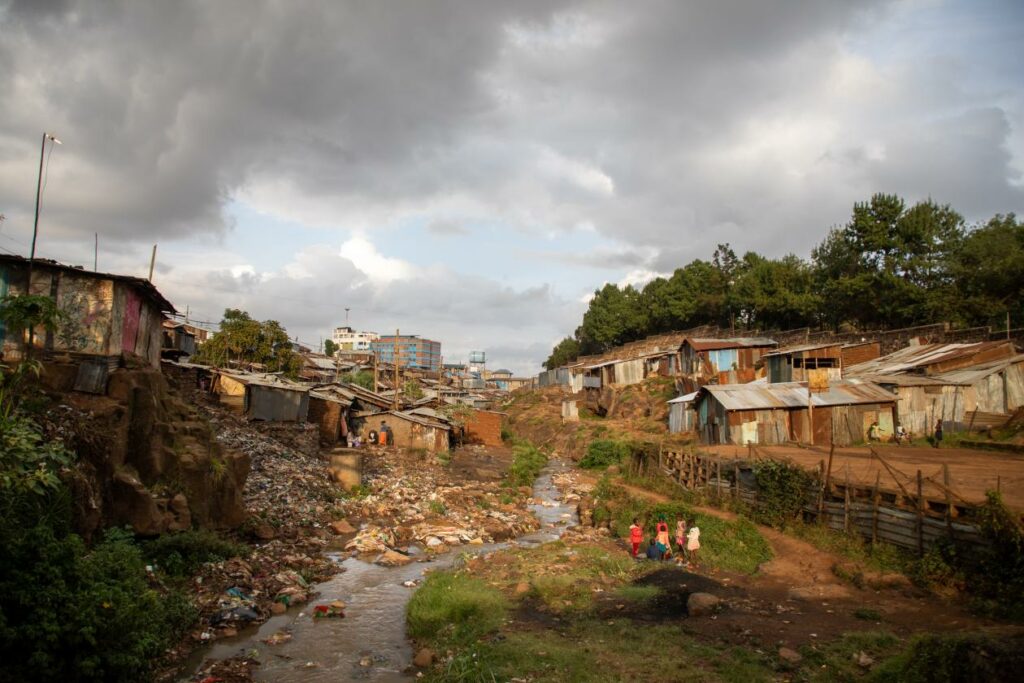
The successes in Kibera and Mukuru have led to slum-city government partnerships that will inform city-wide strategies. These approaches empower local residents to build their resilience, ensuring that the solutions implemented are not out-of-context, ineffective or result in residents becoming displaced (like some urban greening efforts unintentionally cause).
3. Get Finance Right: Aligning Investment Across Sectors
There is a dire gap in funding to meet urban water needs in Africa (and worldwide). A recent ODI report showed that under 1% of climate investment goes to protecting water services for poor communities.
In 2018, the African Development Bank (AfDB) found that the continent needs to spend at least $130 billion to address an infrastructure backlog — including as much as $66 billion on providing universal access to water and sanitation — but there is a financing gap of $68 billion to $108 billion. While this is a high level of investment need, the potential benefits are much higher. The Global Commission on Adaptation’s report indicates that investment in water-related adaptation has benefit-cost ratios that range from 2:1 to 10:1.
Currently, investments are tailored to siloed sectoral needs and disbursed in a piecemeal fashion. This leaves investment unable to reach local levels or capture long-term climate adaptation benefits, and often includes exclusionary criteria. Consequently, money flows fail to incentivize, and sometimes contradict, building resilience. Finance must be more effectively directed to the most vulnerable communities, aligned across levels of government, and targeted to the kinds of green and gray infrastructure projects that build resilience. And it is crucial that investments align with adaptation principles as well as coordinate across sectors.
How to Equitably Increase Investment in Water-Resilience
Here are some key ways to equitably increase water-resilient investment:
First, create mechanisms to disburse funding to the local level. Financial resources are not supporting those who are most impacted by climate and water shocks, and investment priorities are not taking into account the priorities of local communities. IIED research shows that, in recent years, only $1 of every $10 in climate finance reached local levels.
The Devolved Climate Finance Alliance is working to change this, disbursing funds to support community priorities for resilience in Kenya, Mali, Senegal and Tanzania. These efforts should include enhancing access to finance for small-scale water and sanitation service providers (both community-based organizations and the private sector), such as community water kiosks and private pit latrine emptiers. Providing access to microfinance that can help scale and improve service provision is critical for small-scale service providers, who offer essential services to urban poor populations.
Second, support collaborative, regional and cross-sectoral financing mechanisms at the city-region scale to align priorities across groups that share water and areas impacted by water. This is key to devising multi-stakeholder agreements and pooling capital to invest in basin-level resilience across the functional urban region.
One model is The Nature Conservancy’s Water Fund, which brings downstream water users — such as businesses or cities — together to invest in upstream water conservation efforts, resulting in less downstream damage long-term. Water funds for the watersheds of Nairobi, Cape Town and recently Freetown show early success in improving regional restoration and reducing water-intensive, invasive tree species.
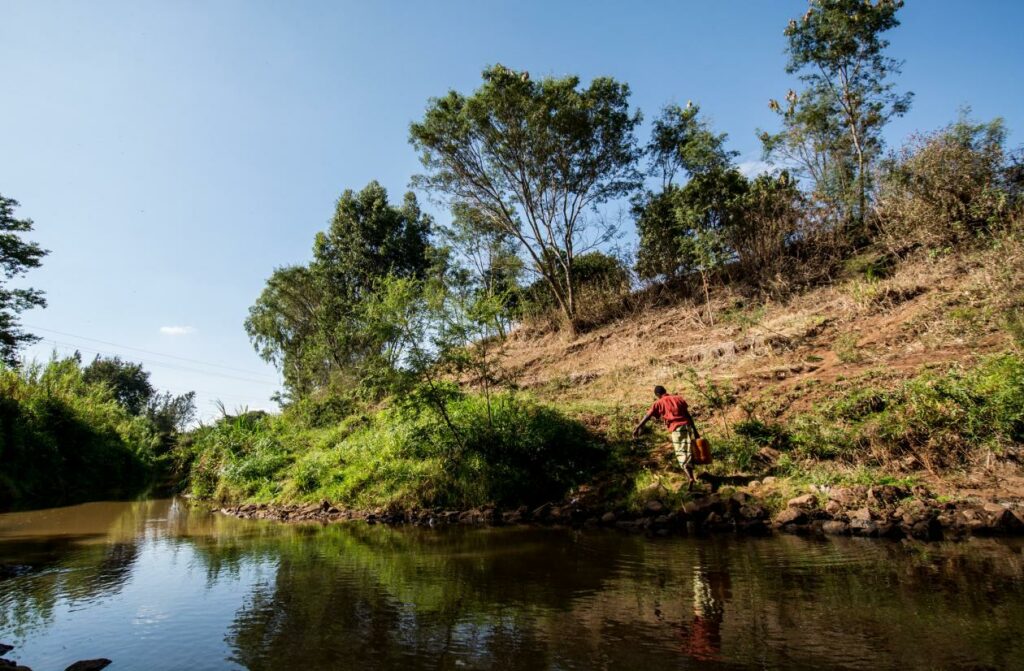
Third, mainstream the economic benefits of adaptation in investment allocations and fiscal planning at the national level. Adaptation actions implemented now to protect livelihoods, ecosystems and economies will pay huge dividends long-term. The true cost of damage and the value of added social, economic and environmental benefits should be included in any development plan.
The Global Commission on Adaptation’s Finance Action Track, with the Coalition of Finance Ministers (CFM), is working to deepen economic understanding of adaptation and shift how investment decisions are made at the national level. The Action Track is designing and implementing capacity building programs for CFM members and line ministries to share best practices, tools for valuation of economic benefits and support peer-exchange, including increasing adaptation finance to the local level.
And finally, increase capacity of city stakeholders, utilities and small service providers to develop green and climate-resilient water projects. Such measures may include offering technical assistance to develop viable business plans for projects, providing innovative risk and social impact seed investment, developing mechanisms to aggregate small, decentralized projects into larger investable pipelines, or increasing credit worthiness of institutions by improving governance, operational performance and providing incremental small loans.
Additionally, the growing green bond and blended finance markets could be tapped into, while driving climate finance to water infrastructure projects. Recent research indicates that these transactions may be as important as the traditional tariffs, taxation and transfers that water sector financing traditionally depends on.
Though still a nascent market in Africa, a recent AfDB assessment indicates that annual financing mobilized through green bond issuance over four years (2010-2014) has exceeded the annual financing mobilized by climate funds over the last 12 years. There is great potential to address financing gaps in building climate resilience and green projects.
In general, African cities have limited local revenue to cover the costs of infrastructure investments. Many cities depend heavily on national transfers and policies that devolve resources, especially for capital investments.
Getting finance right requires active and strategic support from a variety of stakeholders, and given the presence of foreign aid in Africa, multilateral development banks have a significant role in challenging business-as-usual approaches. They should challenge the false choice between green and gray infrastructure and should instead encourage a hybrid portfolio based on local contexts during early planning processes and appraisal processes.
The Time to Scale Impact Across Africa is Now
The urgency on the African continent cannot be overstated. Safeguarding urban water security is essential to delivering many of our development goals — from the Sustainable Development Goals to the Paris Climate Agreement. To not build urban water resilience will hamper development or, even worse, unleash humanitarian disasters and conflict over water resources.
To secure future economic growth and community health in Africa and to build back better from COVID-19, it is critical that stakeholders work together to really make a step change.
The Global Commission on Adaptation has been instrumental in putting adaptation on the agenda and in articulating key areas inextricably linked to it: water, nature-based solutions, cities and locally-led adaptation. The Climate Adaptation Summit this past January saw the launch of the 1000 Cities Adapt Now global program (#1000 CAN), reinforcing the notion that cities have a key role to play in achieving these commitments.
Building urban water resilience in Africa is an integral part of this scaling strategy — due to the sheer scale and impact of urbanization and climate risks on the continent — and the Global Commission on Adaptation created a movement and momentum for climate resilience.
This movement’s success depends on the serious commitments of countries and institutions as well as new approaches to implement the resilience agenda and innovative solutions at scale. COP26 in Glasgow will be a galvanizing moment for the climate agenda globally and the Race to Resilience Campaign, which aims to catalyze a step-change in global ambition to build the resilience of 4 billion people by 2030.
We see an opportunity — and imperative — to ensure that bolstering the water security and climate resilience of growing African cities is a major component of the next decade’s action agenda. The opportunity is to bring together African cities and nations, existing and emerging initiatives, and the donor and finance community, forging a pan-African coalition that can provide access to capital needed to support African cities to grow sustainably, while managing their water resources, providing equitable access to safe water, and mitigating the impact of a changing climate.
The authors wish to acknowledge significant contributions to this Commentary by Jillian Du.
Source : Word Resources Institute

